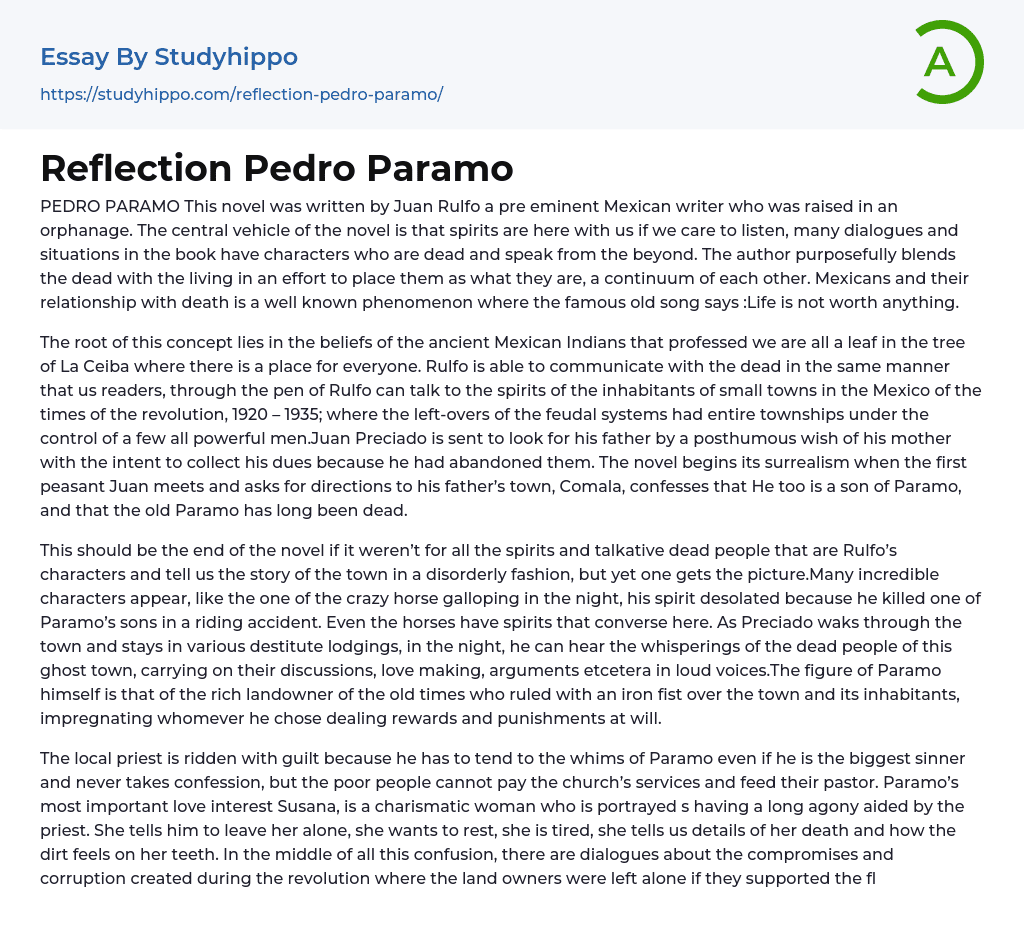PEDRO PARAMO This novel was written by Juan Rulfo a pre eminent Mexican writer who was raised in an orphanage. The central vehicle of the novel is that spirits are here with us if we care to listen, many dialogues and situations in the book have characters who are dead and speak from the beyond. The author purposefully blends the dead with the living in an effort to place them as what they are, a continuum of each other. Mexicans and their relationship with death is a well known phenomenon where the famous old song says :Life is not worth anything.
The root of this concept lies in the beliefs of the ancient Mexican Indians that professed we are all a leaf in the tree of La Ceiba where there is a place for everyone. Rulfo is ab
...le to communicate with the dead in the same manner that us readers, through the pen of Rulfo can talk to the spirits of the inhabitants of small towns in the Mexico of the times of the revolution, 1920 – 1935; where the left-overs of the feudal systems had entire townships under the control of a few all powerful men.Juan Preciado is sent to look for his father by a posthumous wish of his mother with the intent to collect his dues because he had abandoned them. The novel begins its surrealism when the first peasant Juan meets and asks for directions to his father’s town, Comala, confesses that He too is a son of Paramo, and that the old Paramo has long been dead.
This should be the end of the novel if it weren’t for all the
spirits and talkative dead people that are Rulfo’s characters and tell us the story of the town in a disorderly fashion, but yet one gets the picture.Many incredible characters appear, like the one of the crazy horse galloping in the night, his spirit desolated because he killed one of Paramo’s sons in a riding accident. Even the horses have spirits that converse here. As Preciado waks through the town and stays in various destitute lodgings, in the night, he can hear the whisperings of the dead people of this ghost town, carrying on their discussions, love making, arguments etcetera in loud voices.The figure of Paramo himself is that of the rich landowner of the old times who ruled with an iron fist over the town and its inhabitants, impregnating whomever he chose dealing rewards and punishments at will.
The local priest is ridden with guilt because he has to tend to the whims of Paramo even if he is the biggest sinner and never takes confession, but the poor people cannot pay the church’s services and feed their pastor. Paramo’s most important love interest Susana, is a charismatic woman who is portrayed s having a long agony aided by the priest. She tells him to leave her alone, she wants to rest, she is tired, she tells us details of her death and how the dirt feels on her teeth. In the middle of all this confusion, there are dialogues about the compromises and corruption created during the revolution where the land owners were left alone if they supported the flocks of revolutionaries.
This story is a clear representation of the many power plays of
this nature that went on in the Mexico of the period.The author is a powerful writer that rewards the stubborn reader with segments of fascinating and poetic prose like the segment where the women are preparing a wake, lining up the chairs and polishing the face and dress of the deceased who is laid in the middle of the room alone. She died of Tuberculosis, a common fatal illness in those years, no one attends the wake for fear of contracting consumption. The daughter talks to her mother and claims it is better this way, death is not shared with anyone, as if it were goods.
The image of Paramo as a killer and domineering land owner is somewhat softened by his longing for his dead wife, he sits at the entrance of his hacienda every day, looking out at the road where her body left for the cemetery , waiting for her to come back. Pedro Paramo is a magical and surreal masterpiece, those who are lucky enough to read it feel like they can talk to old Mexico through the voice of Juan Rulfo who remains very much alive if only in these pages.
- Book Summary essays
- Metaphor essays
- Reader essays
- Rhyme essays
- Literary devices essays
- Villain essays
- Books essays
- Genre essays
- Literary Criticism essays
- Writer essays
- Protagonist essays
- Simile essays
- Poem essays
- Book Report essays
- Book Review essays
- Greek Mythology essays
- Plot essays
- Tragic Hero essays
- Coming of Age essays
- Play essays
- Rhetoric essays
- Rhetorical Question essays
- Translation essays
- Understanding essays
- Reason essays
- Character essays
- Letter essays
- American Literature essays
- Literature Review essays
- Utopia essays
- Poetry Analysis essays
- Dante's Inferno essays
- Between The World and Me essays
- Incidents in The Life of a Slave Girl essays
- Flowers for Algernon essays
- Myth essays
- Everyday Use essays
- Boo Radley essays
- Genesis essays
- Richard iii essays
- Alice in Wonderland essays
- On the road essays
- Ozymandias essays
- The Nightingale essays
- Holden Caulfield essays
- Animal Farm essays
- 1984 essays
- A Hanging essays
- Shooting An Elephant essays
- A Tale Of Two Cities essays




